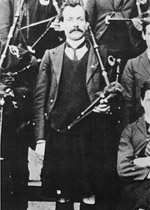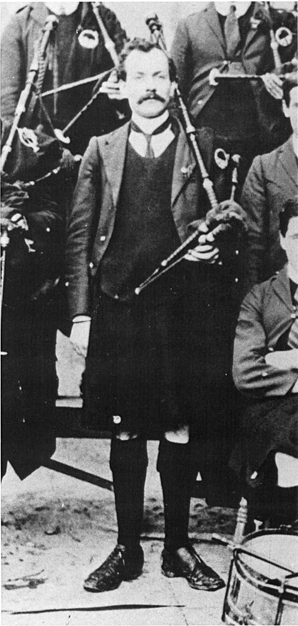George Nichols, Volunteer (17 12 15)

George Nicholls was a young solicitor who worked in G.C. Conroy’s office in Francis Street. In 1912, he set up a pipe band known as “Cumann Píobairí na Gaillimhe”, the only band with an Irish language name to play at O’Donovan Roass’s funeral to which they travelled in the company of Padraic Pearse. Our photograph was taken that year. Nicholls was the nerve centre for the IRB in Galway. He later became the town coroner.
In December 1913 he was involved in setting up a large public meeting in the Town Hall for the purpose of starting the Volunteers in Galway. Mairtín Mór McDonogh was in the chair and the speakers were Roger Casement & Eoin McNeill. On February 8th 1914 Nicholls gave a major speech in Irish & in English at a meeting to form a Volunteer Corps in Athenry. “The Home Rule Bill would bring a certain amount of liberty for the Irish Nation. If however for any unseen calamity the bill could not be carried into law, there needs to be a well organised and disciplined body of men in the country prepared not only to ask the Unionist Government to accede to their demands but to compel them to give a better measure”.
In September 1915, there was a large recruiting meeting for the British Army held in the Town Hall. George Nicholls was in the front row. Professor Dillon of UCG and Tom Hynes had made about 10 stink bombs and some Castlegar fellows smuggled them in past the heavy security. A minute after the meeting began, Tom Hynes, Seamus Carter, John Hosty and Michael Kavanagh cut the electricity wires and George and others let off the stink bombs inside. They were very effective in clearing the house. On the way out, Mícheál Ó Droighneáin was with George when a drummer in St. Patrick’s Brass Band named Kelly went to strike George on the head with his drumstick, but Mícheál grabbed him and forced him to the ground. A little later, George was being threatened by a big man, a boxer named O’Sullivan when Mícheál and his Spiddal pals arrived and surrounded O’Sullivan who beat a hasty retreat. The Spiddal boys accompanied George to his digs at Tandem Lodge, Lower Salthill.
George was one of the chief organisers of the Rising in Galway. Eoin McNeill’s directive cancelling the Rising caused great confusion here as the Volunteers were getting all kinds of messages and counter-messages. On Easter Monday, the RIC went to University Road to George’s house and arrested him. He was taken to Eglinton Street barracks where Mícheál Ó Droighneáin, Seamus Carter and Frank Hardiman were also brought in. They put George and Mícheál handcuffed together in a side car with two policemen with rifles and another policeman driving; they did the same with Seamus and Frank in another side car. They drove them to the docks and on the way the prisoners were pelted with mud by women who had sons or husbands serving with the British Forces. Louis O’Dea followed them to the docks to see if they needed money or anything else.
George Nicholls spoke to a naval officer and asked him to show authority for having them arrested and handcuffed and he said “My word is enough, we are at war”. The prisoners were put on a trawler called the ‘Guillemot’ which was used for minesweeping. Pádraic Ó Máille was brought on board. The following day, Leslie Edmunds, an English official of the Congested Districts Board came on board and in a short time, the ship’s gun fired 14 shells in on the land in the direction of Castlegar. They told the prisoners they were firing at “A meeting of rebels”. Having spent two days and three nights on board, they were transferred to another minesweeper “The Laburnum” where they met 14 other prisoners. Eventually they were sent to Wandsworth Jail and finally to Frongoch, the internment camp in Wales.

